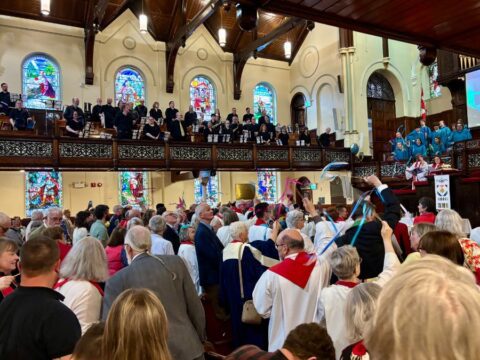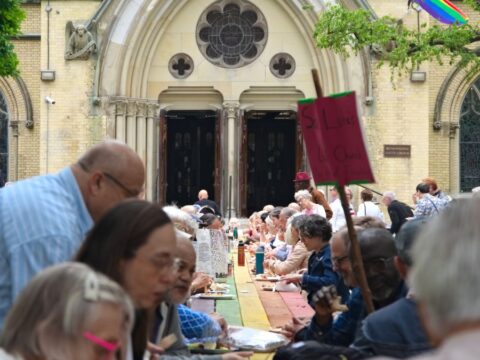An Oshawa, Ont., church is using native plants to help fight climate change. Kedron United created a pollinator garden in 2019 to attract bees, butterflies, hummingbirds and other pollinators.
“We planted iris, blanket flower, milkweed and Russian sage,” says Laura Horner, Kedron’s property manager. The church opted for three garden beds of native plants: one specifically for butterflies, one for hummingbirds and one for bees.
Congregation members realized that helping pollinators was important in adapting to climate change, Horner says. The church was also looking for a community project. Children at nearby Kedron Public School who often walk through the churchyard on their way to class helped with the work.
Bees, hummingbirds and butterflies all contribute to food security. Researchers at the Ontario Agricultural College at the University of Guelph found that many of the foods we eat depend on wild pollinators. Their work proved that managed honeybee stocks can’t keep pace with increased pollinator demands. So if wild pollinators are not encouraged, the agricultural sector risks reduced yields or crop quality.
Native plants are a big help in attracting pollinators. “Native plants have evolved to meet their own needs without human intervention, which means less or no supplemental watering, less need for pest control and fewer invasive weeds,” according to beekeeper Sarah Allinson-Chorabik of Ontario Honey Creations.
More on Broadview:
- How should we navigate the climate crisis?
- How spiritual practices help me navigate my climate grief
- The United Church has an ambitious climate goal — but it needs help from congregations
Once the sunny site for the garden beds was chosen, the next step was digging out the sod and soil and replacing it with soil more appropriate for these plants. “It probably took us pretty well a full day to prep the garden space,” Horner says.
Then the students pitched in. “It was about three hours for us to do the actual planting after that. Once we laid the plants out, the students each had their own shovel and just had a great time.”
Horner says the garden cost about $900 to create. The project didn’t stop there. She plans to get help from Kedron’s Sunday school and teach the children how to care for the environment. “We’re going to have them make some little bee houses, as well as two or three watering stations for the birds, bees and butterflies.”
Almanac.com, the online home of gardening bible The Old Farmer’s Almanac, says bee houses are an important part of luring pollinators to a garden.
Bee houses “attract native solitary bee species,” which are “up to three times more effective as pollinators” than honeybees. “No, you won’t get any honey,” the almanac warns, “but you will enjoy better flowers, thriving plants and healthier vegetables in your garden.”
For now, this happy band of gardeners waits for spring to come and the garden to bloom again. But it is not without charm in the meantime.
“During COVID, a lot of the Sunday school children painted smooth rocks and added a little extra message,” says Horner. “They were all bright and colourful. We spread those throughout the garden.”
The church’s most important message? Horner says they want the community to know it is possible to fight climate change — together. “We can beautify and help the environment. We can help the insect population because the bees and the butterflies and the hummingbirds are important to that general overall cycle of nature. A garden is a special project that just keeps blooming and blooming.”
***
Ashleigh-Rae Thomas is a writer and journalist in Toronto.
This article first appeared in Broadview’s April/May 2024 issue with the title “Kedron United Plants Garden to Attract Butterflies and Other Pollinators.”














